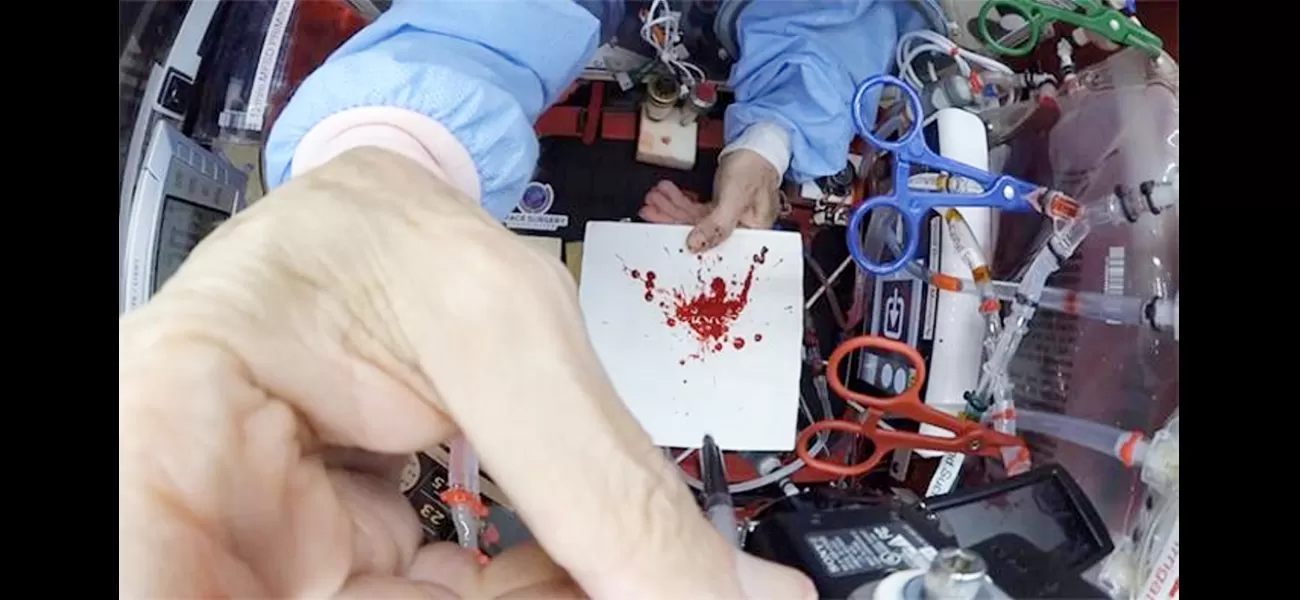How does a space murder differ from one on Earth?
Space detectives use advanced technology to solve mysteries and crimes in the vast expanse of the universe.
March 12th 2024.

In a groundbreaking experiment, researchers conducted bloodstain pattern tests in a reduced gravity environment. The unique opportunity to conduct these tests was made possible by the "Vomit Comet," a modified Boeing 727 parabolic aircraft. Known for its famous passengers, including Stephen Hawking and Martha Stewart, this aircraft has opened up a whole new world of possibilities for scientific research.
The main goal of this experiment was to explore how forensic science could be applied in space. With the hope of aiding future space detectives, a team from Staffordshire University and the University of Hull embarked on this exciting project. The team, which also included a real American CSI investigator pursuing a doctorate, was particularly interested in the challenges of bloodstain pattern analysis in a spacecraft environment.
To simulate the behavior of human blood in microgravity, the researchers used a mixture of 40% glycerin and 60% food coloring. These proportions were chosen to match the relative density and viscosity of human blood. The blood droplets were then released from a hydraulic syringe and studied during periods of reduced gravity, ranging from 0.00 to 0.05g. From the resulting bloodstains, the researchers were able to reconstruct the angle of impact.
The team was led by Zack Kowalske, a Crime Scene Investigator from Atlanta who is currently pursuing a PhD at Staffordshire University. According to Kowalske, studying bloodstain patterns can provide valuable information in solving crimes or reconstructing accidents. However, little is known about how blood behaves in a zero gravity environment, making this study crucial for future forensic investigations in space.
But it's not just about solving crimes. As Kowalske points out, forensic science also plays a crucial role in accident reconstruction and failure analysis. The implications of this research are far-reaching, especially when considering the potential for accidents on space stations or shuttles.
The study revealed some interesting findings about the behavior of blood in space. Due to the lack of gravitational influence, blood droplets are more likely to stick to surfaces. This means that they have a slower spread rate and exhibit shapes and sizes that are not typically seen on Earth. Co-author Professor Graham Williams from the University of Hull explains that this is due to the amplification of surface tension and cohesion in a zero gravity environment.
This is the first study to examine the behavior of blood in free flight, and the researchers emphasize the need for reliable forensic science techniques in a rapidly evolving technological landscape. As Kowalske puts it, we are in a new era of forensic science, with new questions arising about how different environments can affect the evidence. He believes that "astroforensics" is a new and important subdiscipline that will be critical as humanity ventures further into space.
The study, which is published in Forensic Science International: Reports, highlights the need for further research across all disciplines to broaden our understanding of forensic science in non-terrestrial environments. As we continue to explore and expand as a space-faring species, reliable and accurate forensic techniques will be crucial in solving crimes and understanding accidents in space.
The main goal of this experiment was to explore how forensic science could be applied in space. With the hope of aiding future space detectives, a team from Staffordshire University and the University of Hull embarked on this exciting project. The team, which also included a real American CSI investigator pursuing a doctorate, was particularly interested in the challenges of bloodstain pattern analysis in a spacecraft environment.
To simulate the behavior of human blood in microgravity, the researchers used a mixture of 40% glycerin and 60% food coloring. These proportions were chosen to match the relative density and viscosity of human blood. The blood droplets were then released from a hydraulic syringe and studied during periods of reduced gravity, ranging from 0.00 to 0.05g. From the resulting bloodstains, the researchers were able to reconstruct the angle of impact.
The team was led by Zack Kowalske, a Crime Scene Investigator from Atlanta who is currently pursuing a PhD at Staffordshire University. According to Kowalske, studying bloodstain patterns can provide valuable information in solving crimes or reconstructing accidents. However, little is known about how blood behaves in a zero gravity environment, making this study crucial for future forensic investigations in space.
But it's not just about solving crimes. As Kowalske points out, forensic science also plays a crucial role in accident reconstruction and failure analysis. The implications of this research are far-reaching, especially when considering the potential for accidents on space stations or shuttles.
The study revealed some interesting findings about the behavior of blood in space. Due to the lack of gravitational influence, blood droplets are more likely to stick to surfaces. This means that they have a slower spread rate and exhibit shapes and sizes that are not typically seen on Earth. Co-author Professor Graham Williams from the University of Hull explains that this is due to the amplification of surface tension and cohesion in a zero gravity environment.
This is the first study to examine the behavior of blood in free flight, and the researchers emphasize the need for reliable forensic science techniques in a rapidly evolving technological landscape. As Kowalske puts it, we are in a new era of forensic science, with new questions arising about how different environments can affect the evidence. He believes that "astroforensics" is a new and important subdiscipline that will be critical as humanity ventures further into space.
The study, which is published in Forensic Science International: Reports, highlights the need for further research across all disciplines to broaden our understanding of forensic science in non-terrestrial environments. As we continue to explore and expand as a space-faring species, reliable and accurate forensic techniques will be crucial in solving crimes and understanding accidents in space.
[This article has been trending online recently and has been generated with AI. Your feed is customized.]
[Generative AI is experimental.]
0
0
Submit Comment





